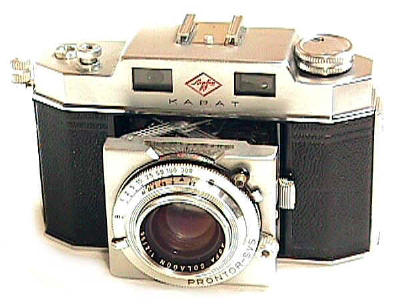
Home Camera Articles FOR SALE Orders I Buy / Wants Repairs Books Adapters
Agfa Karat IV -- Classic but relatively unknown 50's folder

Most experienced photogs are aware of Agfa, the renowned German manufacturer of film, photographic paper, and one of the best B/W developers of all time, Rodinal. Most US photogs are probably not aware of Agfa's many 35mm cameras. Famous as a camera manufacturer they are not, at least not in the US. Yet Agfa contributed many excellent 35 designs from the 30's to the late 50's. Starting in 1937, Agfa manufactured a series of Karat folding 35's to compete in the then popular 35mm folder class made popular by the Kodak Retina series. Don't know what a folder is? Generically it's a camera which folds, or in this case collapses, into a smaller size for convenient carrying. The concept is still being used today in various Autofocus Point and Shoots with collapsible lenses -- the Canon ELPH is a prime example.
The Agfa Karat IV is the last and most feature laden of the Karat series. Produced from 1950 to 1956 in at least four variations with the Solinar 50/2.8, Solagon 50/2.0, Xenon 50/2.0, and Apotar 50/3.5. It is a very worthy competitor to the more famous Retina IIIc or IIIC. Today in the US the Karat IV is hard to find. The Karat was also imported to the US under the Ansco Karamat. I understand earlier Karats used the special Agfa quick load film cartridges. The IV was the first Karat to use standard 35mm film cartridges.
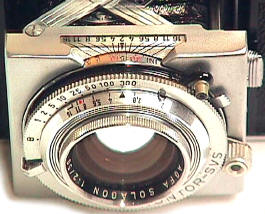
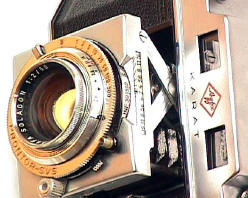
The f/stops, shutter speeds, distance scale, and depth of field scale are all quickly seen by the photog looking down at the camera held in their hands. The large knurled chrome knob near the "SVS" in the first pic is the focusing lever. The lens assembly collapses back into the body, without a front door clam shell. Flash sync at all speeds, shutter speeds are 1 to 1/300th plus B using a Prontor shutter. Thankfully there is no EV settings to lock the shutter speed/f stop combinations. The lens is an excellent quality six element 50/2 Agfa Solagon. The Karat has no capacity for interchangeable lenses like the later Retina folders. If you have used the often large and ungainly accessory lenses on the Retinas, you might wonder why Kodak went to the trouble. I suppose it was for bragging rights in advertising. Real world, Retina accessory lenses went against the Retina concept of a small compact camera.
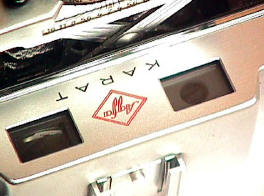
The Karat has what I consider to be a larger, better rangefinder/viewfinder than the later Retina folders, though no brightline as in the Retina IIIC. It is a very large and bright rangefinder viewfinder for its type. No brightlines or parallax correction.
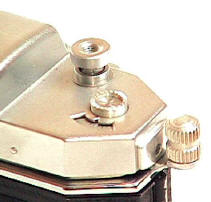
The Karat IV has an unusual non-ratcheted top right lever advance, which you pull towards you rather than away from you. In practice it is very convenient, much more so than the odd bottom lever advance on many Retinas.
The IV enjoys a better, simpler, frame counter than the Retina IIIc or IIIC. Unlike the contraption on the later Retinas, this framecounter is easy to work.
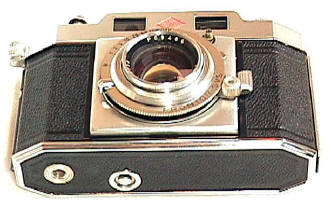
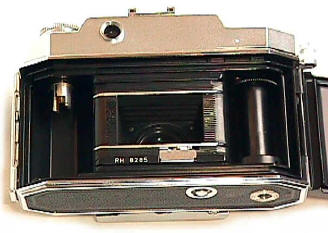
The chrome button on the left front of the body collapses the lens. Pushing it again releases the spring to extend the lens. The film advance can not be used if the lens is collapsed. The back opens for easy film loading. No hot shoe, you connect the flash to shutter. Weight almost 1 1/2 lbs -- the price for real metal instead of real plastic. With the "M X V" on the Prontor shutter you can select X sync, Flashbulb sync, or self timer.
The Karat IV accessory list was short, but useful: camera case, Proximeter I close-up device for 40 to 20 inches, Proximeter II for 20 to 13 inches, both Proximeter I and II combined for 13 to 10 inches, Agfa filters of light yellow, medium yellow, yellow-green, and orange-red. The leather cases are very high quality for a medium priced camera. The Proximeter came complete with an auxiliary finder which eliminated parallax at close distances. Today the Proximeter is very hard to find, at least in the US.
My thanks to Bogdan Karasek for supplying some information on the Karat. He is now working on a Karat book.
In practical terms the Agfa Karat IV is well finished and designed. It's an excellent shooter of its type and deserves more recognition today.
Home Camera Articles FOR SALE Orders I Buy / Wants Repairs Books Adapters
Revised: November 25, 2003 . Copyright � 1998-2002 Stephen Gandy. All rights reserved. This means you may NOT copy and re-use the text or the pictures in ANY other internet or printed publication of ANY kind. Information in this document is subject to change without notice. Other products and companies referred to herein are trademarks or registered trademarks of their respective companies or mark holders.